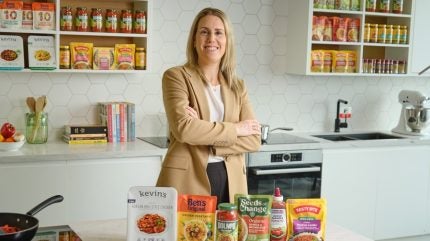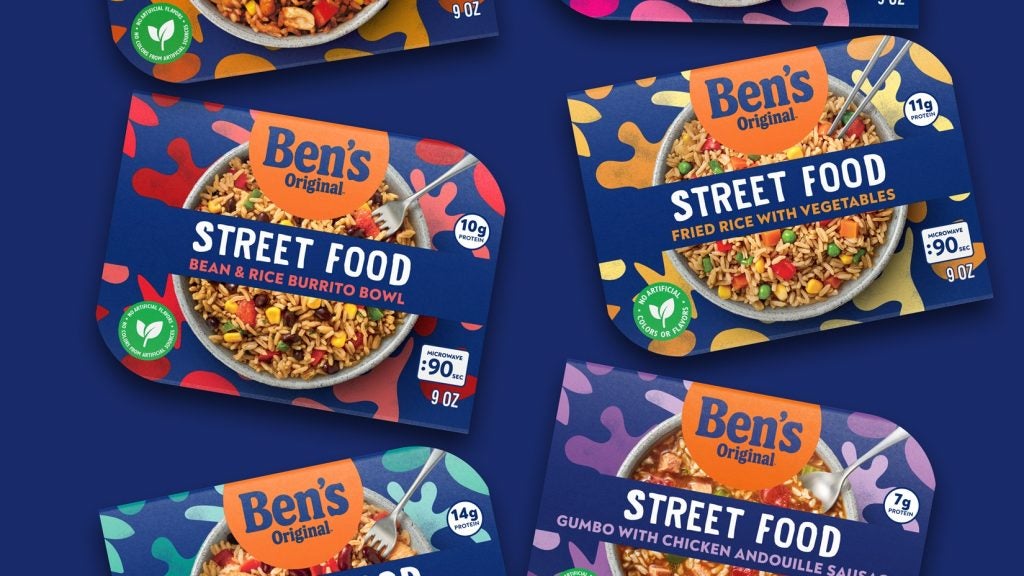
Mars’ latest innovation in food features a range of ready meals centred on convenience for the busy consumer looking for a quick and easy in-home solution, while also aspiring to cater to more exotic tastes.
Health has been a consideration, too, behind a new ‘street food’ line-up under the legacy Ben’s Original brand – Jamaican jerk beans and rice; gumbo chicken; and teriyaki rice with chicken; for example.

Discover B2B Marketing That Performs
Combine business intelligence and editorial excellence to reach engaged professionals across 36 leading media platforms.
And Mars is seeking to take its Dolmio Italian sauces into new areas inspired by Mediterranean classic dishes, with ambient meals such as spicy chorizo fusilli and prosciutto tortellini.
As innovation becomes increasingly important for food manufacturers in the recent era of lost volumes due to inflation-linked pricing, Just Food’s Simon Harvey chats with Karina Zimerfeld, the global vice president of R&D for Mars’ food and nutrition business.
Simon Harvey (SH): What does your role in R&D entail?
Karina Zimerfeld (KZ): I look into what our consumers want in meals and cooking ingredients and then I make sure we create magic through our products and packaging and processes. Then ensuring that we can actually produce that with the right quality.
SH: With the debate around ultra-processed foods and the rise of MAHA in the US, what is the biggest issue on Mars’ plate at the moment when it comes to innovation and addressing consumer needs?
KZ: Consumers are asking for multiple different things, what I would say the magic triangle – products that are tasty, convenient and healthy.

US Tariffs are shifting - will you react or anticipate?
Don’t let policy changes catch you off guard. Stay proactive with real-time data and expert analysis.
By GlobalDataIf you are able to address all of those needs and wants from a consumer standpoint and do that in a way that doesn’t harm our planet or protects our planet and supports our farmers, you will have an opportunity to not only do the right thing for consumers but also to grow in the industry.
SH: Is Mars aggressively going after the consumer that wants functionality, foods that bring a benefit to them?
KZ: We’re seeing consumers are currently much more interested in experimenting. Our intention is to cater to consumers who are aware of the need for products that are good for them and nutritious, that will help them to thrive, live a long, healthy life but not necessarily specifically looking to one area of benefit. Catering to the broad consumer cohort.
Logically, there are areas, namely, protein and fibre, that we know are very relevant to consumers and therefore areas we are also very interested in. Using food ingredients that are wholesome and healthy, like whole grains, vegetables and legumes, and then taking our culinary expertise with our chefs to design a combination of ingredients in a meal that tastes amazing. Millennials and Gen Z are much more open to exploring; 66% of that population is now interested in spicy foods.
The key markets around the world for Mars’ food and nutrition segment are in the UK and Europe, North America and Australia, where we have incredible products behind our core.
We’re bringing innovation behind brands such as Ben’s Original, Seeds of Change, Dolmio and, if you go to Australia, MasterFoods. Side dishes or meals or meal components or ingredients that are helping consumers to create great, delicious dishes.
SH: There’s often criticism lodged at ‘Big Food’ of sideways or bolt-on innovation around legacy brands, brands that don’t always resonate with Gen Z. Is it a case that companies like Mars need to be more adventurous and come out with ground-breaking innovation with new brands?
KZ: We’ve been very lucky with the brands that we have. We’ve recently acquired Kevin’s Natural Foods in the US, which probably fits into the younger generation cohort that’s interested in eating healthy, delicious food.
We absolutely are leveraging our existing brands because they are very strong
Even with our legacy brands that we’ve had for decades – Ben’s Original, Seeds of Change, Dolmio – I think we’ve been very lucky. What we see is, as we innovate, be it within the spaces we have already such as pasta sauces with Dolmio, side dishes with beans, or entering new adjacencies with ready meals, we’ve been very lucky that our brands really resonate with our consumers.
It’s fertile soil because it gives me the opportunity to innovate without having to wait for us to invent something completely new as a new brand. We absolutely are leveraging our existing brands because they are very strong. They have a lot of equity with our consumers of all ages.
Innovating in new spaces is recognising that the consumer does evolve. New generations come in, they are interested in new things.
Hence the Ben’s Original street-food products we have just launched in the UK. They are tasty, convenient and nutritious. We’re seeing a lot of traction behind those innovations because they have been able to really address and tackle all of those needs simultaneously.

SH: Is Mars more inclined to add ground-breaking innovation through M&A with new brands rather than in-house product development?
KZ: I can’t comment on future acquisitions but what I would say is, if you look at where we are and how we’ve been evolving with our portfolio, innovating within our brands is extremely important.
If heritage brands have been present in the life of the consumer, to not continuously seek to understand where consumers are and where they are heading you will struggle to continue to exist. What are the pain points? What do they need? What do they want? And to try and predict what products they might need in the future.
SH: How is Mars employing AI tech to do that and identify existing trends and potential new entry points?
KZ: AI is extremely powerful to help us to get those insights to understand and to read trends. What are the taste flavour trends that are coming up? Often, for example, things that are trending in restaurants will then cut across into the industry in maybe one or two years.
What are consumers looking for when they are searching for recipes, which flavours are they looking for, which combinations and how can I predict through AI tools, what they will need next based on patterns that we see?
Street food, for example. I could spend ages creating dishes to put in front of consumers so they could appraise the dishes. But I could also leverage AI. What is the contrast between vegetables and pasta and noodles that they are expecting? If I’m leveraging AI, I can do that much more efficiently and effectively.
SH: If everybody is employing AI and getting the same results, how does Mars stay ahead of the competition?
KZ: We know in generative AI, the prompt you put in defines the outcome you have, in general. In AI, in any technology that you’re leveraging, it is about how the brains that are behind that resource are feeding it in order to utilise it in the best way. So, continuing to nurture capabilities and knowledge and insights within the company is going to be a critical success factor for you to leverage those resources in the proper way.
AI doesn’t eliminate the need for us to continue to work on science and technology, consumer insights and culinary expertise
You might be able to read the need but you still will need a lot of expertise to be able to create the products in the right way. AI doesn’t eliminate the need for us to continue to work on science and technology, consumer insights and culinary expertise.
SH: I can understand street foods might be a popular innovation but pasta and sauce is a rather crowded aisle with lots of choice, so what’s Mars’ thinking behind the new Dolmio range?
KZ: It’s interesting because you might observe the shelf of tomato sauces and think consumers have had enough but we have observed that consumers take pasta sauce and they tweak it. So, it’s understanding consumer behaviour to see what they want when they are experimenting with new flavours.
We see ready meals as an area that gets a lot of consumer interest. Street food meets that sweet spot of consumer needs that have not been properly tackled – either they were super tasty and indulgent but failed to deliver the healthy aspect of it, or they were interesting but they were still cumbersome to prepare.
Delivering ready meals through some of our brands, including Dolmio pasta sauce, is creating an opportunity for consumers to finally have all of those needs addressed at the same time.
We tell people they need to eat diverse diets that contain fibre and protein but we tend to forget the time it takes to prepare. If we can offer, say, an Asian noodles option that is tasty, accessible and healthy, I am solving a big tension, a big pain point for consumers. I do think that is an area that will continue to be explored in the future.





